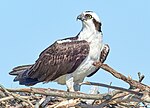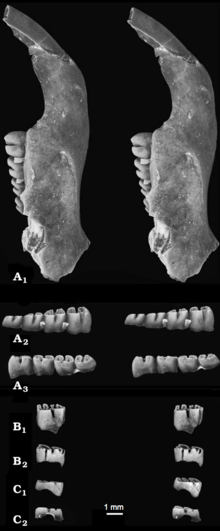The Barstovian North American Stage on the geologic timescale is the North American faunal stage according to the North American Land Mammal Ages chronology...
4 KB (252 words) - 22:31, 23 January 2022
determined to have come from the lower Valentine Formation, making them late Barstovian in age. Leidy reassigned the specimens to Pseudaelurus as Pseudaelurus...
20 KB (1,305 words) - 11:44, 12 May 2024
Aelurodon (category Barstovian)
extinct canid genus of the subfamily Borophaginae which lived from the Barstovian land mammal age (16 mya) of the middle Miocene to the late Miocene epoch...
6 KB (420 words) - 06:42, 4 September 2024
L. Warter in 1976 was found in marine Middle Miocene deposits of the Barstovian age in the southern part of California. The second species Pandion lovensis...
49 KB (5,156 words) - 02:05, 15 September 2024
Asia's Middle Miocene and North America's late Hemingfordian to late Barstovian epochs. In the Early or Middle Miocene, the saber-toothed Machairodontinae...
49 KB (3,882 words) - 18:03, 20 September 2024
Mammal Ages Hemphillian (10.3 to 4.9 Ma) Clarendonian (13.6 to 10.3 Ma) Barstovian (16.3 to 13.6 Ma) Hemingfordian (20.6 to 16.3 Ma) Arikareean (30.6 to...
97 KB (10,227 words) - 14:10, 10 August 2024
species are known, including Haematopus sulcatus (Brodkorb, 1955) from the Barstovian of Florida and Zanclean of North Carolina, and which is evidently considered...
13 KB (1,131 words) - 15:55, 1 July 2024
living from the Duchesnean stage of the Late Eocene through to the early Barstovian stage of the Miocene, lasting around 20 million years. It comprises 10...
5 KB (392 words) - 06:52, 19 March 2023
of Zygolophodon from North America is Z. proavus, which occurs in the Barstovian and Clarendonian stages. M? furlongi from the Black Butte in Oregon also...
166 KB (18,670 words) - 05:50, 12 September 2024
Herpetological Species and Records from the Norden Bridge Fauna (Miocene: Late Barstovian) of Nebraska". Transactions of the Nebraska Academy of Sciences and Affiliated...
27 KB (2,410 words) - 04:07, 4 September 2024
"Cormohipparion n. gen. (Mammalia, Equidae) from the North American Miocene (Barstovian-Clarendonian)". Journal of Paleontology. 51 (5). Paleontological Society:...
10 KB (914 words) - 17:50, 31 August 2024
Ursinae Temporal range: Barstovian–Recent PreꞒ Ꞓ O S D C P T J K Pg N A Eurasian brown bear (Ursus arctos arctos) Scientific classification Domain: Eukaryota...
5 KB (359 words) - 16:36, 7 July 2024
Florida) †Anaxyrus valentinensis (Estes & Tihen, 1964) (Middle Miocene (Barstovian) of Nebraska) "Anaxyrus Tschudi, 1845 | Amphibian Species of the World"...
9 KB (573 words) - 21:32, 22 March 2024
Guanajuato. The fossils date in time from the oldest dating from the Barstovian in the Miocene to the youngest dating in the Hemphillian faunal stage...
4 KB (344 words) - 15:38, 17 February 2024
Mergus miscellus is known from the Middle Miocene Calvert Formation (Barstovian, c.14 million years ago) of Virginia, USA. Mergus connectens lived in...
15 KB (1,026 words) - 06:15, 19 September 2024
Andrias matthewi Temporal range: Arikareean–Barstovian PreꞒ Ꞓ O S D C P T J K Pg N Size comparison between a human and A. matthewi Scientific classification...
5 KB (500 words) - 17:27, 16 August 2024
Barstow Formation (category Barstovian)
million years ago) in age, in the Neogene Period. It lends its name to the Barstovian North American land mammal age (NALMA). The sediments are fluvial and...
7 KB (630 words) - 02:36, 12 April 2024
Calippus (mammal) (category Barstovian)
and Protohippus (Mammalia, Perissodactyla, Equidae) from the Miocene (Barstovian-Early Hemphillian) of the Gulf Coastal Plain" (PDF). Bulletin of the Florida...
3 KB (220 words) - 00:13, 11 September 2024
inhabited most of North America during the late Early Miocene to the Early Barstovian age of the Middle Miocene (23—16 million years ago). Tomarctus existed...
4 KB (281 words) - 00:09, 6 July 2024
Teleoceras (category Barstovian)
Teleoceras Temporal range: Barstovian-Hemphillian ~15.97–4.9 Ma PreꞒ Ꞓ O S D C P T J K Pg N Specimen at the Natural History Museum of LA 1913 T. fossiger...
11 KB (990 words) - 16:07, 18 August 2024
North American Land Mammal Ages (NALMAs) Hemphillian, Clarendonian, and Barstovian. It also includes an excellent record of grass seeds and other plant seeds...
12 KB (1,316 words) - 12:59, 26 September 2023
is representative of the Barstovian Land Mammal age. In 1941 Rainbow Basin was designated the type reference for the Barstovian Land Mammal age by the North...
8 KB (796 words) - 18:06, 10 September 2024
formation of the isthmus. Condor-like forms in North America date back to the Barstovian stage (middle Miocene, 11.8 – 15.5 Ma ago). This is based on the definition...
175 KB (18,173 words) - 10:22, 6 September 2024
Mint Canyon Formation (category Barstovian)
formation preserves fossils dating back to the Middle to Late Miocene (Barstovian and Clarendonian in NALMA classification). Mint Canyon is a fluvial landform...
7 KB (411 words) - 03:46, 17 July 2024
and Protohippus (Mammalia, Perissodactyla, Equidae) from the Miocene (Barstovian-early Hemphillian) of the Gulf Coastal Plain", Bulletin of the Florida...
4 KB (299 words) - 21:22, 8 July 2024
recombined its type species, Chelydrops stricta from the Miocene (Early Barstovian) of Nebraska, as the (then) fourth species of Macrochelys. There are two...
6 KB (574 words) - 17:56, 10 April 2023
Pliohippus (category Barstovian)
Pliohippus Temporal range: Barstovian-Hemphillian ~15.97–4.9 Ma PreꞒ Ꞓ O S D C P T J K Pg N Pliohippus pernix skull Scientific classification Domain: Eukaryota...
3 KB (261 words) - 15:43, 17 February 2024
Amphicyon ingens This huge species lived during the early to middle Barstovian, 15.8–14.0 Mya. It was originally described by W. Matthew in 1924 from...
74 KB (8,562 words) - 22:10, 9 September 2024
known from fragmentary jaws and isolated teeth from a site in the early Barstovian, around 15–16 million years ago, of Nevada. Together with other species...
13 KB (1,443 words) - 00:21, 18 February 2022
Godwit Temporal range: Barstovian–recent Black-tailed (front) and Bar-tailed godwit (back) Scientific classification Domain: Eukaryota Kingdom: Animalia...
9 KB (865 words) - 18:46, 16 September 2024


























